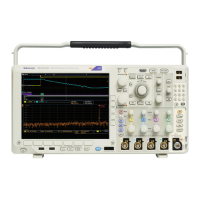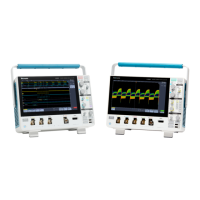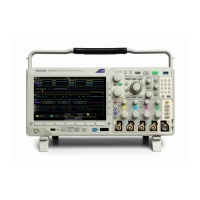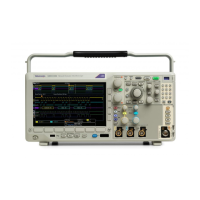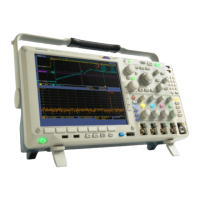
Do you have a question about the Tektronix MDO4104-6 and is the answer not in the manual?
| Brand | Tektronix |
|---|---|
| Model | MDO4104-6 |
| Category | Test Equipment |
| Language | English |
Details product warranty terms, conditions, and exclusions for defects in materials and workmanship.
Defines terms like WARNING and CAUTION used in the manual for hazard identification.
Explains symbols and terms that may appear on the product itself for user guidance.
Lists Electromagnetic Compatibility (EMC) standards and declarations the instrument complies with.
Details safety compliance standards, including Low Voltage Directive and US/Canadian listings.
Explains pollution degree ratings for product usage environments.
Highlights the main capabilities and features of the MDO4000 series oscilloscopes.
Explains icons and conventions used throughout the manual for clarity.
Guides on unpacking, checking standard accessories, and initial setup.
Details operating voltage, temperature, humidity, and altitude specifications.
Provides instructions on how to clean the oscilloscope and probes.
Explains how to connect various types of Tektronix probes to the oscilloscope.
Describes how to use a security lock to secure the oscilloscope.
Guides on powering the oscilloscope on/off and performing functional checks.
Details probe compensation, free trial, and installation of application modules.
Guides on changing language, date/time, signal path compensation, and upgrading firmware.
Describes methods for connecting the oscilloscope to a computer for data analysis.
Guides on setting up analog channels and labeling them for signal acquisition.
Covers default setup, autoset, acquisition concepts, modes, and roll mode.
Guides on setting up buses, digital channels, and MagniVu.
Details how to configure RF input parameters like frequency and span.
Explains trigger concepts, holdoff, slope, and level settings.
Guides on choosing and selecting various trigger types.
Explains how to trigger on various data buses.
Covers managing waveform display, style, persistence, and intensity.
Guides on waveform scaling, input parameters, bus signals, and digital channels.
Explains digital channel viewing, screen annotation, and trigger frequency display.
Covers frequency domain display, trace types, detection, RF traces, and spectrograms.
Guides on using markers and taking automatic measurements in the frequency domain.
Covers automatic and manual measurements, customization, and cursor usage.
Details histogram setup, math waveforms, FFT, and spectrum math.
Covers reference waveforms, wave inspector, search/mark, multi-domain display, mask testing, and power analysis.
Covers file structure, naming, saving screen images, waveforms, and trace data.
Details setup saving/recalling, one-button save, file management, and network drives.
Guides on setting up and performing printing operations.
Guides on using TekSecure to securely erase oscilloscope memory.
Introduces optional application modules that extend oscilloscope capabilities.
Lists analog channel input impedance, capacitance, gain accuracy, and bandwidth specs.
Details horizontal scale accuracy and random noise specs.
Lists digital acquisition and RF channel specifications.
Details specs for input/output ports and external reference input.
Covers probe operating info, connection, compensation, and standard accessories.
Details probe accessories, specs, environment, compliance, and safety.
Describes the P6616 logic probe and its connection to the oscilloscope.
Guides on connecting to the circuit and performing a functional check.
Illustrates application, lists accessories, and details probe specifications.
Outlines safety precautions for using the logic probe.




